Struggling to grow fresh veggies in your garden? You might have an incompatible mix of companion plants growing together!
Growing certain fruits, veggies, flowers and herbs together (i.e. companion plants) can encourage faster growth, better flavours, natural ground cover and shade, improved soil nutrition and more. Some companion plants can even attract pollinators while also repelling pests — a wonderful win-win situation.
It’s important to plan ahead and choose the right companion plants based on what veggies you’re trying to grow. Here, we share a huge range of companion planting vegetables and combinations that will guarantee a larger, healthier, and more successful crop — read on!
Cucumber companion plants
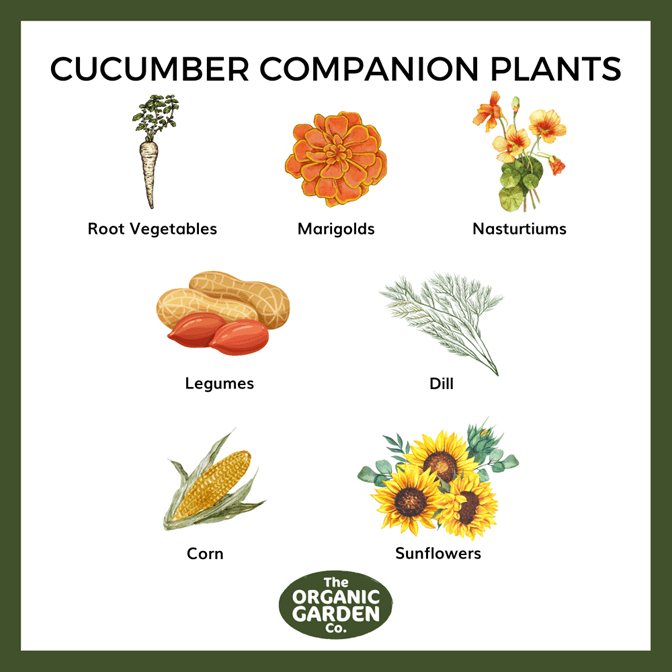
Cucumbers are excellent veggies for beginners to grow. They’re incredibly easy to grow and have many companion planting vegetables, herbs and flowers for a healthier, more successful crop, including:
- Root vegetables — Cucumbers have one large taproot, while their remaining roots remain thin and shallow. This means that cucumbers won’t interfere with root veggies like carrots, radishes and turnips if you plant them nearby.
- Nasturtiums & marigolds — These beautiful flowers attract aphids, so we recommend planting them near cucumbers, but not too close. This will keep the aphids away from your veggies!
- Legumes — Think sugar snap peas and green peas. Legumes add nitrogen to the soil that cucumbers need to thrive.
- Dill — Dill is an incredibly beneficial companion plant as it attracts beneficial insects and pollinators like parasitic wasps that pollinate cucumbers and keep pest levels down. It can also improve the flavour of mature cucumbers.
- Corn — Corn stalks can be used as trellises for vining cucumbers, saving on space and maximising garden efficiency and growth. Meanwhile, your cucumber vines will act as mulch under the corn stalks, retaining moisture and eliminating weeds.
- Sunflowers — Tall sunflower stalks can act as natural trellises for vining cucumbers. Just make sure to harvest your cucumbers when they’re small, like pickling cucumbers. Sunflower stalks won’t be able to support full-sized cucumbers!
At the same time, you should not plant cucumbers near potatoes and brassicas like cabbages, cauliflowers and kale because they are very thirsty plants and will compete for moisture in the soil. Melons and cucumbers also aren’t friends, as they have similar growing requirements and attract the same pests.
Broccoli companion plants
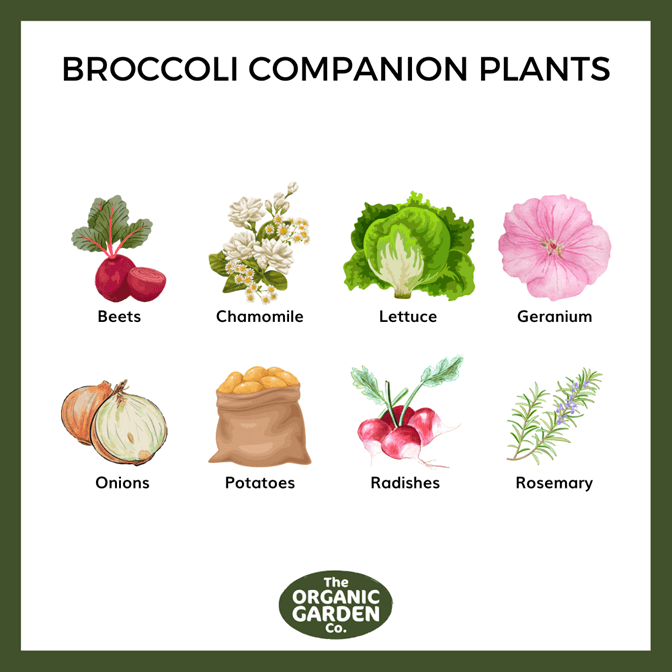
Broccoli is part of the cabbage family (brassicas) and is always a crowd-pleaser — whether you’re having a baked dinner, putting together a cheesy oven casserole, or even just getting the little ones to eat their greens.
Broccoli tends to attract pests, so it’s important to plant broccoli alongside companion plants that repel pests. Plus, companion plants can also help broccoli grow in a number of other wonderful ways!
- Beets — Broccoli tends to soak up all the calcium in the soil, but beets aren’t bothered by this. They can still thrive alongside broccoli and will even add magnesium to the soil.
- Chamomile — This delicate flower improves broccoli’s flavour, making it sweeter!
- Lettuce — Broccoli offers protective shade for lettuce, helping it grow more easily.
- Geranium — Like nasturtium, geraniums repel cabbage worms and loopers with their peppery aroma.
- Onions — Broccoli can develop a better, sweeter flavour when grown near onions.
- Potatoes — Despite soaking up most of the nutrients in the soil, potatoes and broccoli grow quite well next to each other.
- Radishes — Like lettuce, radishes need cool shade to thrive. Mid-season broccoli can provide the shade radishes need!
- Rosemary — This fragrant herb deters cabbage flies from laying eggs in your broccoli.
On the flip side, you should avoid planting “heavy feeders” like strawberries near your broccoli, as your broccoli will struggle to get enough nutrients. Likewise, it is not recommended to plant other brassicas because they will compete for nutrients and space.
Carrot companion plants
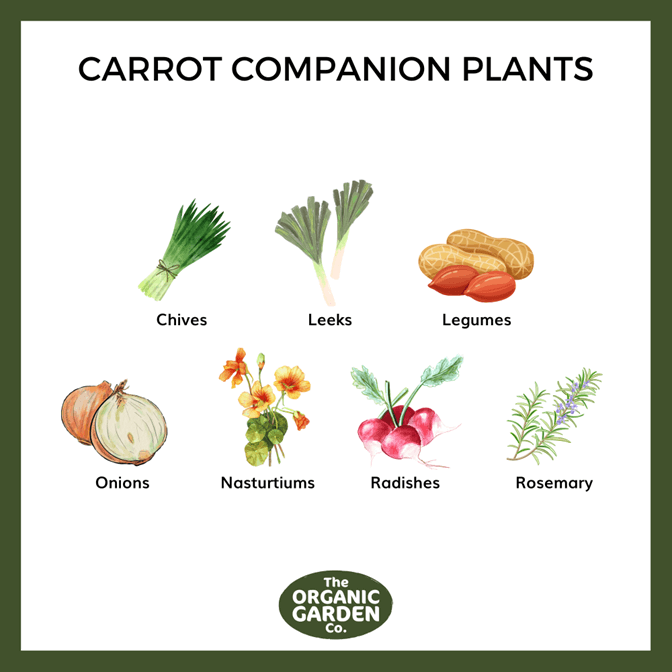
Every veggie patch should have a healthy carrot crop! Perfect for snacks, soups, baked dinners and more, carrots come with their own list of companion planting vegetables and herbs.
- Chives — As well as deterring aphids and other pests from feasting on your carrots, chives can also improve the flavour and texture of carrots.
- Leeks — Carrots and leeks are best friends in the veggie patch. Leeks deter carrot flies, and carrots repel leek moths!
- Legumes — Legumes can affect the nitrogen in your soil, leading to healthier soil for carrots to grow.
- Onions — Carrots love growing alongside onions, as onions deter a huge range of pests!
- Nasturtiums — Nasturtiums repel aphids and cucumber beetles while also attracting pollinators. These gorgeous flowers are the best friend of almost every plant!
- Radishes — Carrot roots need loose soil to spread throughout the garden and grow. Radishes tend to loosen up the soil and germinate faster than carrots, so we recommend planting radish and carrot seeds simultaneously for excellent companion growth.
- Rosemary — Like other fragrant herbs like sage, rosemary helps deter carrot rust flies.
Conversely, we recommend keeping dill plants away from your carrots, as dill can stunt their growth. Likewise, fennel should be kept as far away from carrots as possible — fennel attracts a lot of pests, so consider planting fennel on the opposite side of the garden to draw pests away from your carrots.
Potato companion plants
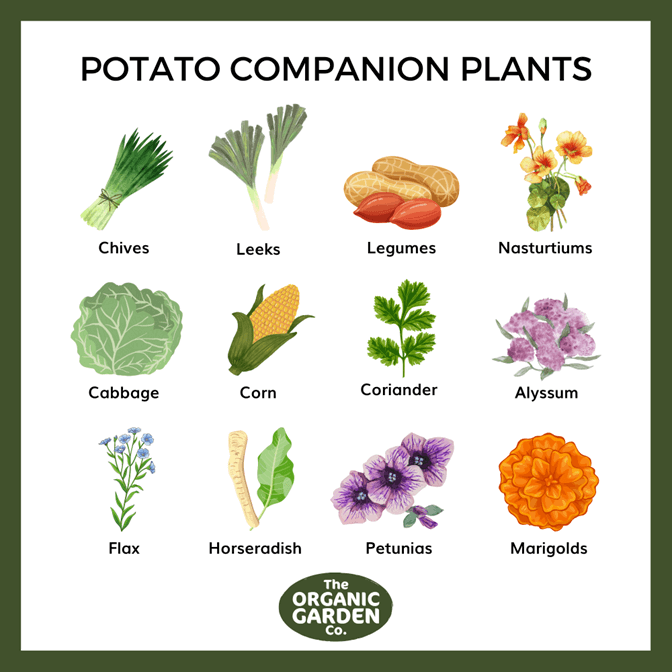
Potatoes are starchy veggies and are generally easy to grow. Plus, there are countless varieties of potatoes that you can grow in your garden that you wouldn’t typically find at your local grocery store.
- Chives — As well as being delicious served on top of baked potatoes with sour cream or butter, chives also attract beneficial pollinators to potatoes and take up minimal space, allowing potatoes to spread and grow.
- Leeks — A shallow-rooted allium, leeks are an excellent potato companion plant — they leave plentiful space for potatoes to grow.
- Legumes — Snow peas and green beans grow well with potatoes, adding nitrogen to the soil for excellent growth. Potatoes are also known to deter pests that often feed on legumes.
- Nasturtiums, marigolds, petunias & alyssum — All of these flowers attract beneficial pollinators and repel pests that feed on potatoes. Alyssum can also serve as natural mulch, retaining moisture in the soil and deterring weeds.
- Cabbage — Cabbage (and most brassica family members) have shallow roots and won’t compete for space with potatoes.
- Corn — If you want to save on space but still produce a large crop, we recommend planting corn and potatoes together. Corn grows tall and has shallow roots, while potatoes grow deep underground, so there’s plentiful space for these companion plants.
- Coriander & flax — Coriander is a delicious herb that attracts ladybugs and hoverflies, which eat potato beetles and other pests. Likewise, the linseed oils and tannins in flax can deter the same pests!
- Horseradish — Amazingly, horseradish can actually improve your potato plant’s disease resistance.
While potatoes have quite a few companion planting vegetables, they also have a lot of enemies! Other root vegetables like carrots, turnips and parsnips use the same underground space and will compete with potatoes for space. At the same time, some fruits and berries like raspberries and tomatoes can suffer from similar diseases like blight.
Corn companion plants
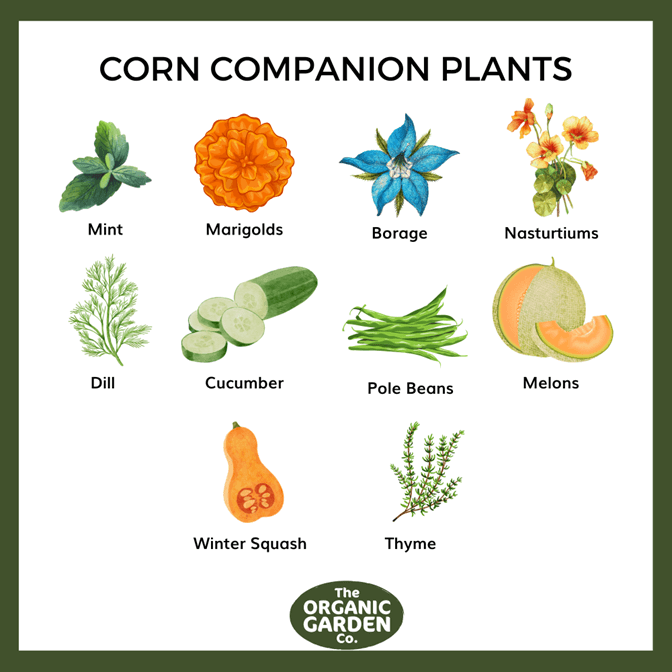
Corn plants have shallow roots and grow tall, meaning there are a number of companion plants you can grow alongside corn.
- Mint — Growing corn can attract a lot of pests, but herbs from the mint family, like sage, can help deter grazing animals and bugs.
- Marigolds — Aphids love to snack on corn stalks, but marigolds repel these pests.
- Borage & nasturtiums — Borage is a tall, beautiful blue flower that attracts beneficial pollinators and insects while also deterring worms from eating your corn. Meanwhile, nasturtiums can attract aphids, so they’re best planted away from your corn to catch aphid attention.
- Dill — This buttery-scented herb attracts pollinators like parasitic wasps that help pollinate corn and keep pest levels down in your veggie patch.
- Cucumber, winter squash and melons — Cucumber and melon plants spread out along the ground, providing ample coverage and shade for corn while also keeping the soil moist.
- Pole beans or green beans — As climbing plants, beans can use corn stalks as a natural trellis for growth. In return, beans will add nitrogen to the soil, cultivating healthy growth for your corn.
- Thyme — Thyme repels one of the most common pests in cornfields — earworms!
Like potatoes, corn shouldn’t be planted near brassica family members — but not for the same reasons. For example, broccoli, cabbage and cauliflower are “heavy feeders” and will compete with corn for nutrients in the soil. Plus, growing corn plants will throw shade across your garden, while brassicas need sunlight to thrive.
Spinach companion plants
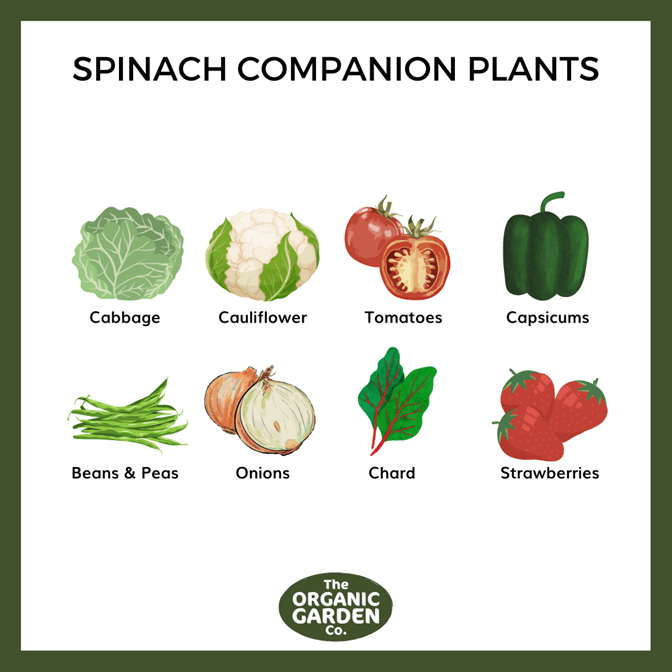
Spinach can be an interesting challenge for beginner gardeners. It grows well in the cooler seasons, doesn’t grow tall (so there’s no need for a trellis or tall companion plants like corn), and likes moist, nitrogen-rich soil.
So what companion planting vegetables and herbs work with spinach?
- Cabbage & cauliflower — Brassicas and spinach have root systems at different layers of the soil, meaning they won’t compete for nutrients and moisture.
- Tomatoes & capsicums — Spinach grows very quickly, so we recommend planting spinach with slower-growing fruits like tomatoes and capsicums. Once your spinach is harvested, your tomatoes and capsicums will have more room to grow and mature.
- Beans & peas — As part of the legume family, beans and peas add nitrogen to the soil to help spinach grow.
- Onions — Spinach has a tap root, while onions grow from a bulb near the surface of the soil. This means the two plants won’t compete for nutrients and will give each other space to grow.
- Chard — Growing spinach and chard together can have some benefits, but keeping an eye on pests is important. These two plants tend to attract the same pests — consider planting a beneficial flower like marigolds or nasturtium nearby to attract these pests.
- Strawberries — Spinach contains saponins, a natural repellent for common garden pests that feed on strawberries. These two plants make the best of friends in veggie patches!
Lettuce companion plants
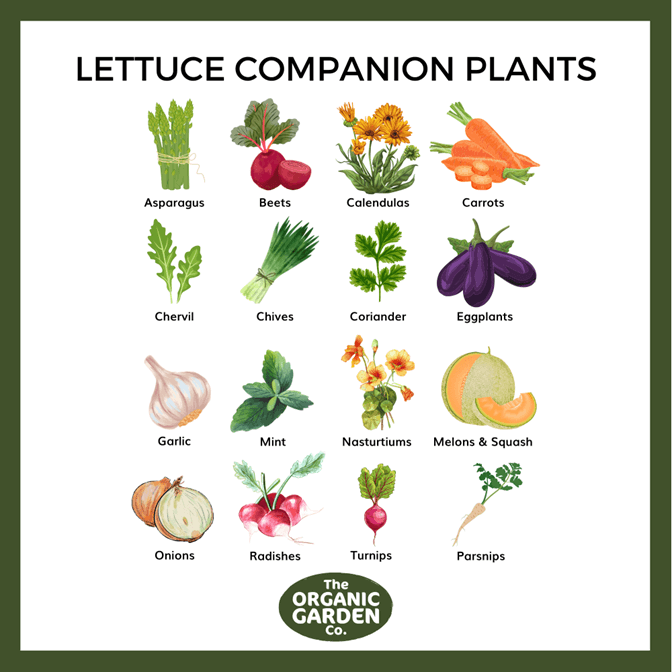
Lettuce is one of the easiest, leafiest veggies to grow in your garden. It has a huge selection of companion planting vegetables and herbs for exceptional growth.
- Asparagus — Asparagus plants can grow tall, and its leaves can spread like fern leaves, providing shade for lettuce plants that suffer in the afternoon sun.
- Beets & carrots — Lettuce plants have very shallow roots, whereas beets use underground space to grow. These companion plants can be planted close together and won’t compete for nutrients or space.
- Calendulas, nasturtiums & chervil — Plant calendula and chervil on the opposite end of your veggie patch to attract slugs and other pests away from your lettuce!
- Chives & garlic — Consider planting chives and garlic as a barrier between rows of lettuce — aphids will go for the chives and garlic before even looking at the lettuce.
- Coriander — This fragrant herb repels pests and attracts beneficial pollinators, so be sure to plant coriander next to your lettuce for success.
- Eggplants — Eggplants tend to thrive in warmer conditions, unlike lettuce — so when it comes time to harvest your lettuce, your eggplant will have loads of space to grow and thrive in the summer.
- Mint — Members of the mint family (like sage) tend to repel slugs, so feel free to plant mint close to your lettuce for protection.
- Melons, squash and radishes — Lettuce is a fast-growing plant, especially in infancy. Melons, squash and radishes are slow-growers, so once you’ve harvested your mature lettuce, these fruits and veggies can take over the space naturally.
- Onions & parsnips — Where lettuce has shallow roots, onions and parsnips use underground space to grow. This means you can plant more in a smaller space!
- Turnips — This root vegetable repels aphids, so be sure to plant it near lettuce to protect the lettuce leaves.
In terms of companion planting vegetables and herbs to avoid, we recommend keeping fennel and brassicas away from the lettuce. Brassicas have root secretions that can prevent lettuce seeds from growing.
Onion companion plants
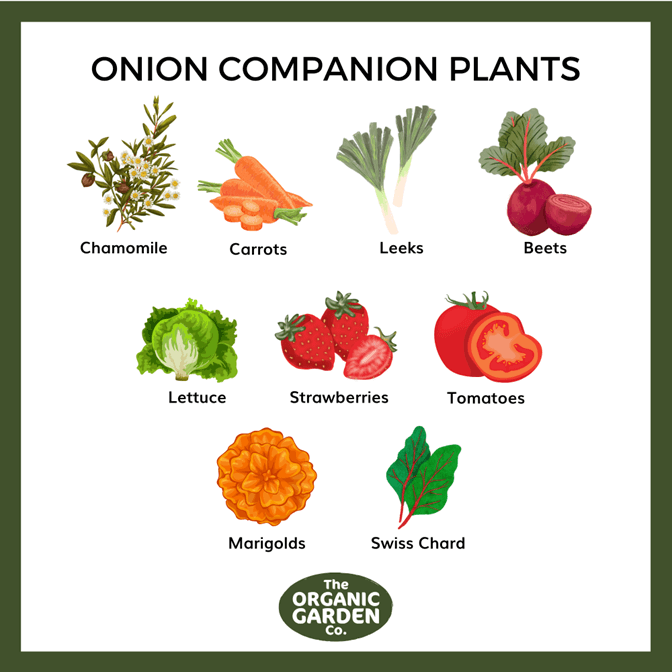
Onions are unique in improving the flavour of companion plants and keeping pests like aphids and rabbits away from your crops. Here are a few companion plants to grow near or alongside your onion crop.
- Chamomile — Good for you in a cup of tea and good for your crops; chamomile has antibacterial and antifungal properties, which can improve the flavour of your onions.
- Carrots — Onions are beneficial for growing carrots, as they repel carrot flies and other pests that can ruin carrot crops.
- Leeks — Onions and leeks are part of the same family and have similar growing requirements, e.g. nutrition.
- Beets — Like leeks and garlic, beets deter common garden pests as well as animals like rabbits.
- Lettuce — Lettuce has shallow roots, whereas onion takes advantage of the extra space underground. These two plants can be planted together without competing for space or nutrients.
- Strawberries & tomatoes — Aphids love strawberries, which is why keeping these berries free of disease and destruction is challenging. Onions naturally repel aphids, allowing you to grow a healthier, happier strawberry crop — and the same can be said for tomatoes!
- Marigold — This aromatic flower attracts beneficial pollinators and feeds other pests that ravage your garden.
- Swiss chard — Chard has large leaves that provide shade for other companion plants that need moist soil to grow.
Cabbage companion plants
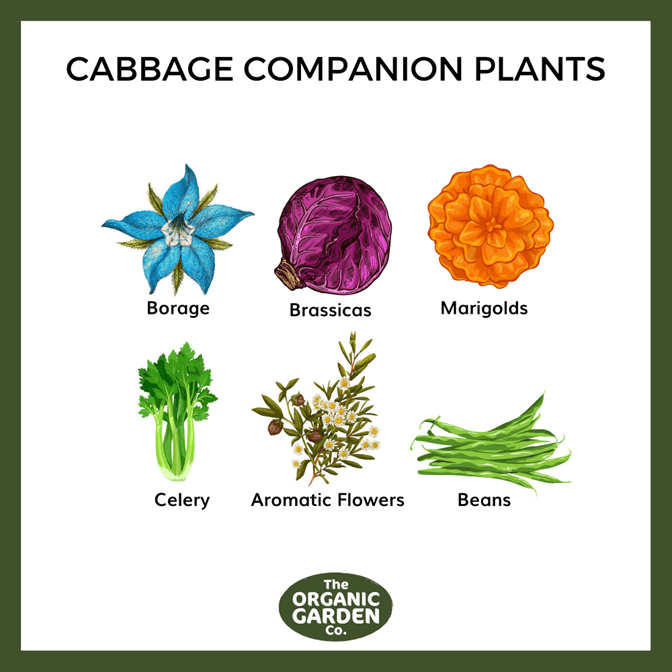
Cabbage is a very easy brassica to grow and can survive frosts in the middle of winter. With this in mind, cabbage grows well alongside other brassica family members and companion plants, including:
- Borage — This pretty blue flower attracts beneficial insects like bees and pollinators to your cabbage patch.
- Brassicas — Other brassica family members, like kale, broccoli, cauliflower and Brussels sprouts, grow well with cabbage as they have the same nutritional needs.
- Marigolds — This flower deters mosquitos, flies and other common pests like aphids, cucumber beetles and vine borers.
- Celery — Celery has a unique aroma that deters cabbage moths.
- Aromatic flowers — Chamomile, chives, coriander, dill, mint, thyme, geranium, sage and oregano all repel insects like cabbage moths and spider mites while also adding flavour to cabbage with vitamins and nutrients like calcium and sulphur.
- Beans — Beans can grow tall with big leaves, helping to block the sun over shade-loving cabbages.
Bean companion plants
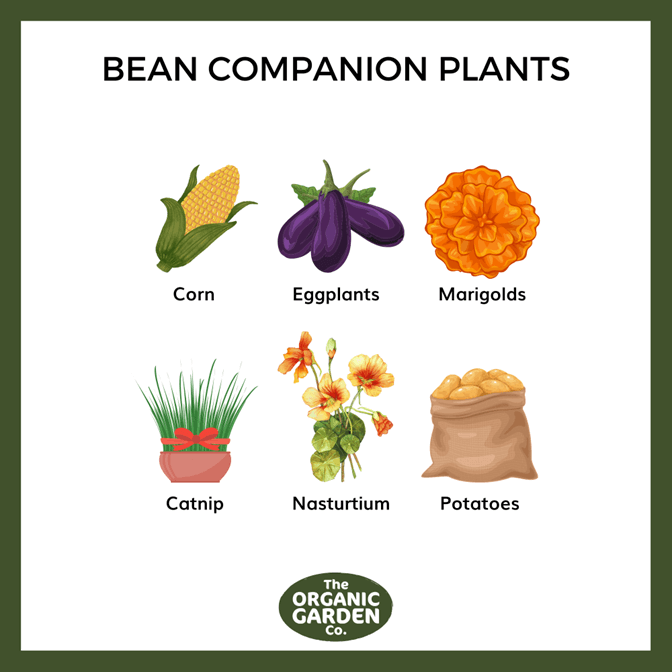
Beans and other legume family members inject much-needed nitrogen into the soil, making them the perfect companion planting vegetables for other plants like:
- Corn — Corn stalks can act as a natural trellis for bean plants to grow tall. Plus, beans tend to like the shade that corn leaves provide.
- Eggplants — Veggies like eggplants, cucumbers and radishes need nitrogen-rich soil to grow. With this in mind, beans are a natural companion to these vegetables!
- Marigolds — These flowers are a recommended companion for a huge range of fruits and veggies, including beans. Marigolds deter common garden pests, so your beans grow tall and healthy.
- Catnip — Catnip repels a range of pests, including flea beetles. Plus, if you have cats at home, they’ll love snacking on this pet-friendly plant!
- Nasturtium — Plant nasturtium near your beans to deter common beetles and pests. It’s important not to plant beans and nasturtiums too close together, as beans can throw too much shade, preventing your nasturtiums from growing.
- Potatoes — Beans repel potato beetles, and potatoes repel bean beetles — the pairing just makes sense!
Meanwhile, you should avoid planting beans near allium family members like onions, leeks, garlic and shallots. Alliums can inhibit bean plant growth and prevent beans from adding nitrogen to the soil — this can be a major problem for the other fruits and veggies in your garden.
Likewise, if you’re growing sunflowers, keep beans at the opposite end of the garden — sunflowers give off a chemical compound that inhibits bean growth!
Pea companion plants
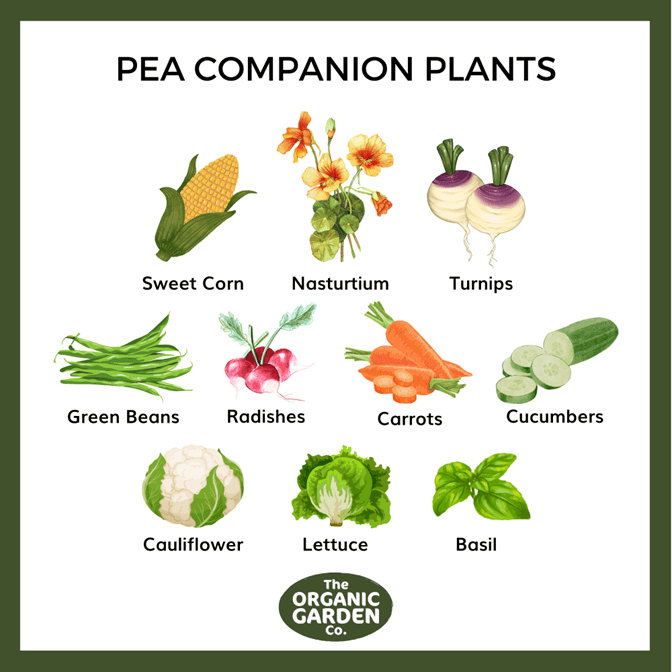
Whether you’re growing snow peas, snap peas or traditional garden peas, all peas help other plants grow through a process called “nitrogen fixation”. Like beans, peas add beneficial nitrogen to the soil to help other fruits and veggies grow more successfully.
- Sweet corn — Sweet corn is the ideal pea companion plant because the stalks act as a natural trellis for the pea tendrils.
- Nasturtium — If you want aphids to stay away from your peas, we recommend planting nasturtiums near your pea plants. Nasturtiums are so appealing to aphids that it’ll be like your peas don’t even exist!
- Turnips — Peas add nitrogen to the soil around turnips to grow, and in return, turnips repel harmful aphids from attacking pea plants. The same can be said for cauliflower — it thrives on the nitrogen peas produce.
- Green beans & cucumbers — Peas, beans and cucumbers have similar growing requirements, so they’re natural companions in your veggie garden.
- Radishes — A fast-growing root vegetable, radishes can grow undisturbed next to peas — a slower-growing plant.
- Carrots — Peas and carrots both thrive in cool, moist conditions and can tolerate a light frost in the wintertime.
- Lettuce — Lettuce and other leafy veggies like spinach need lots of nitrogen to grow, so peas and lettuce are excellent companion planting vegetables. Plus, they both have similar growing requirements!
- Basil — Thrips love pea plant flowers and are known to damage developing pea pods, but basil’s natural oils can deter these pests.
Pumpkin companion plants
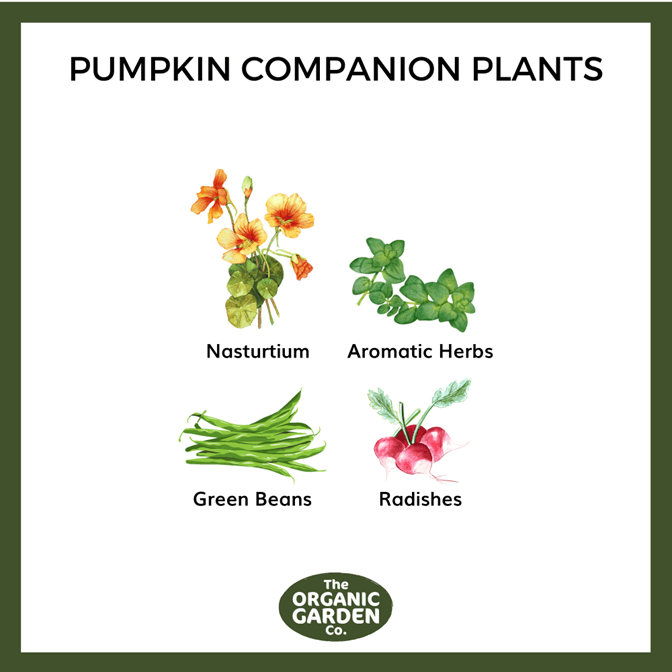
Pumpkins tend to attract a lot of pests — vine borers, aphids and cucumber beetles, to name a few. With this in mind, we recommend planting companion plants that are tolerant to heat and attract beneficial pollinators, like:
- Nasturtium — This pepper-scented flower attracts natural predators to pests like aphids and pumpkin beetles.
- Aromatic herbs — Think chamomile, marjoram, chives and oregano. These herbs provide excellent ground cover and attract hoverflies that feed on aphids. Marjoram can also improve your pumpkin harvest’s flavour.
- Green beans — Beans feed nitrogen into the soil, while pumpkin leaves act as a natural mulch and form of weed control for beans and other companion plants like corn.
- Radishes — Flea beetles are attracted to radishes, so this is a great choice if you’re looking for a natural pest repellent. Basil and catnip can also be beneficial for this reason.
Pumpkins should not be planted with potatoes and brassica family members (e.g. cauliflower, kale and Brussels sprouts), as they have similar growing requirements and may compete for nutrients in the soil.
Radish companion plants
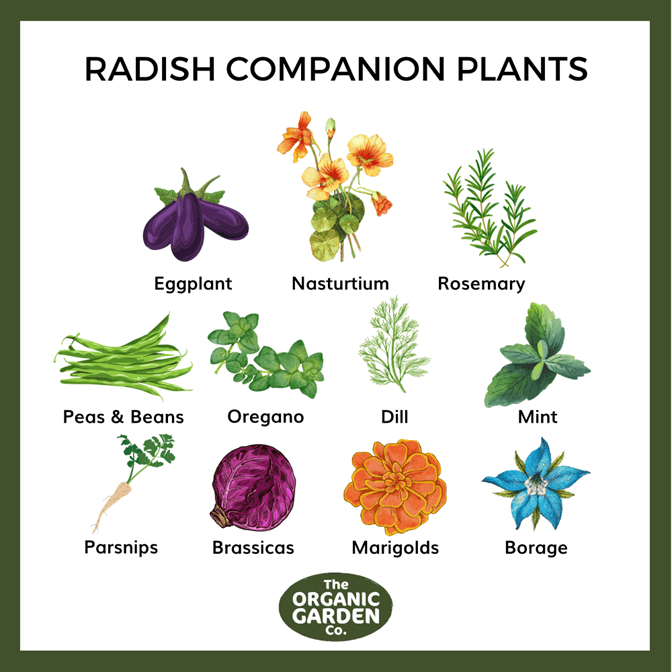
Radish is a root vegetable in the brassica family that’s packed with essential vitamins and minerals — plus, they’re very easy to grow with other companion plants like:
- Eggplant — Large eggplants provide lots of shade for radishes to grow. In return, radishes repel pests away from your eggplants.
- Nasturtium — This delicate flower attracts aphids, which is why many gardeners choose to plant nasturtium a little way away from their veggie patches. Aphids will head for the nasturtium before eating your fresh veggies.
- Rosemary & oregano – Rosemary’s aroma repels pests like carrot flies, bean beetles and cabbage moths away from your growing radishes.
- Peas & beans — Peas and beans add some much-needed nitrogen into the soil, which is required for radishes to thrive.
- Dill — This potent herb attracts beneficial insects and pollinators like parasitic wasps, who pollinate radish plants and keep pest levels down.
- Mint — Mint plants like hyssop and sage repel grazing animals, ultimately protecting your radishes.
- Parsnips — These root veggies attract ladybugs and spiders, which repel pests like root maggots and vine borers.
- Brassicas — Broccoli, spinach and kale add nutrients to the soil that your radishes need to survive.
- Marigolds & borage — These flowers are low-maintenance and attract pollinators while also deterring pests like worms.
Mix and match your companion planting vegetables in our raised garden beds!
Looking for a quick and simple way to start a veggie patch in your backyard? We recommend investing in a raised garden bed or two! Our Colorbond garden beds can be clipped together in six simple steps, so you can start mixing and matching companion plants in a matter of minutes.
We recommend planting root vegetables that thrive in loose, partially sandy soil, like radishes, onions, shallots and garlic. The soil inside raised garden beds is less compacted than a traditional garden bed, because there’s no foot traffic to compress it down.
Browse through our collection of Colorbond raised garden beds and find a colour and shape that suits your garden!












